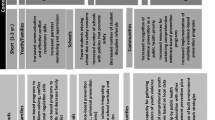Abstract
The State of the Science Conference Statement on “Preventing Violence and Related Health-Risking Social Behaviors in Adolescents” accurately summarizes the state of knowledge regarding risk factors for violence and intervention efficacy. The Statement missed an opportunity, however, to move the field of prevention practice and policy forward by advocating for more systematic, central review of preventive interventions through a new federal regulatory body, such as an “FDA for Preventive Interventions.” This body would provide review of evidence-based programs and aid decision-making in funding. As a complement to this body, decision-makers also need guidelines in evidence-based practice in ambiguous circumstances, which characterize much of the reality of public policy. Therefore, this new regulatory body should be accompanied by guidelines for evidence-based practice in intervention and policy. Finally, in order to move forward both of these concepts, a National Academy of Sciences Panel should convene to deliberate how these concepts can be implemented.
Similar content being viewed by others
References
Arum, R., & Beattie, I. (1999). High school experience and the risk of adult incarceration. Criminology, 37, 515–537.
Coalition for Evidence-Based Policy. (2003). Bringing evidence-driven progress to crime and substance-abuse policy: A recommended federal strategy. Final report available at http://coexgov.securesites.net.
Coalition for Evidence-Based Policy. (2005). Initiative with U.S. Public Policy Schools To Provide Students With Skills in Evidence-Based Policymaking. Report available at http://coexgov.securesites.net.
Cho, H., Hallfors, D., & Sanchez, V. (2005). Evaluation of a high school peer group intervention for at-risk youth. Journal of Abnormal Child Psychology, 33, 363–374.
Dishion, T. J., McCord, J., & Poulin F. (1999). When interventions harm: Peer groups and problem behaviors. American Psychologist, 54, 755–764.
Dodge, K. A., Dishion, T. J., & Lansford, J. E. (2006). Deviant by design: The problem of deviant peer influences in intervention programs. In K. A. Dodge, T. J. Dishion, & J. E. Lansford (Eds.), Interventions and policies that aggregate deviant youth, and strategies to optimize outcomes. New York: Guilford Press.
Elliott, D. S., & Mihalic, S. (1997). Blueprints for violence prevention. Boulder, CO: University of Colorado Center for the Study and Prevention of Violence, Institute of Behavioral Science. Available at http://www.colorado.edu/cspv/bluprints/.
Ennett, S. T., Tobler, N. S., Ringwalt, C. L., & Flewelling, R. L. (1994). How effective is drug abuse resistance education? A meta-analysis of Project D.A.R.E. outcome evaluations. American Journal of Public Health, 84(9), 1394–1401.
Feldman, R. A., Caplinger, T. E., & Wodarski, J. S. (1983). The Saint Louis Conundrum: The effective treatment of antisocial youth. Englewood Cliffs, NJ: Prentice Hall.
James-Burdumy, S., Dynarski, M., Moore, M., Deke, J., Mansfield, W., & Pistorino, C. (2005). When schools stay open late: The national evaluation of the 21st Century Community Learning Centers Program: Final report. U.S. Department of Education, Institute of Education Sciences, National Center for Education Evaluation and Regional Assistance. Available at http://www.ed.gov/ies/ncee.
Kew, O. (2005). A vaccine disaster and its fateful shadow. Science, 310, 975.
Kingery, P. (2000). Zero tolerance: The alternative is education. Washington, DC: Hamilton Fish Institute.
McCord, J. (2003). Cures that harm: Unanticipated outcomes of crime prevention programs. Annals of the American Academy of Political and Social Science, 587, 16–30.
Offit, P.A. (2005). The Cutter Incident: How America's first polio vaccine led to the growing vaccine crisis. New Haven: Yale University Press.
Sherman, L. W., & Strang, H. (2004). Verdicts or inventions?: Interpreting results from randomized controlled experiments in criminology. American Behavioral Scientist, 47, 575–607.
Skiba, R. J., & Peterson, R. L. (1999). The dark side of zero tolerance: Can punishment lead to safe schools? Phi Delta Kappan, 80, 372–376, 381–382.
Straus, S. E., Richardson, W. S., Glasziou, & Haynes, R. B. (2005). Evidence-based medicine: How to practice and teach EBM (Third Ed). Churchill Livingstone: Edinburgh.
Woody, S. R., Weis, J., & McLean, C. (2005). Empirically supported treatments: 10 years later. The Clinical Psychologist, 58, 5–11.
Author information
Authors and Affiliations
Rights and permissions
About this article
Cite this article
Dodge, K.A. Professionalizing the Practice of Public Policy in the Prevention of Violence. J Abnorm Child Psychol 34, 475–479 (2006). https://doi.org/10.1007/s10802-006-9040-0
Published:
Issue Date:
DOI: https://doi.org/10.1007/s10802-006-9040-0




